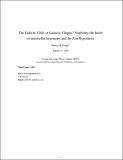Files in this item
The Galactic Club or Galactic Cliques? Exploring the limits of interstellar hegemony and the Zoo hypothesis
Item metadata
| dc.contributor.author | Forgan, Duncan H. | |
| dc.date.accessioned | 2017-05-28T23:34:16Z | |
| dc.date.available | 2017-05-28T23:34:16Z | |
| dc.date.issued | 2017-10 | |
| dc.identifier | 248156387 | |
| dc.identifier | f89da2ec-51ae-4407-991c-1f39a90b826d | |
| dc.identifier | 84997194290 | |
| dc.identifier | 000410001700006 | |
| dc.identifier.citation | Forgan , D H 2017 , ' The Galactic Club or Galactic Cliques? Exploring the limits of interstellar hegemony and the Zoo hypothesis ' , International Journal of Astrobiology , vol. 16 , no. 4 , pp. 349-354 . https://doi.org/10.1017/S1473550416000392 | en |
| dc.identifier.issn | 1473-5504 | |
| dc.identifier.uri | https://hdl.handle.net/10023/10869 | |
| dc.description | The author gratefully acknowledges support from the ECOGAL project, grant agreement 291227, funded by the European Research Council under ERC-2011-ADG and the STFC grant ST/J001422/1. | en |
| dc.description.abstract | The Zoo solution to Fermi's Paradox proposes that extraterrestrial intelligences (ETIs) have agreed to not contact the Earth. The strength of this solution depends on the ability for ETIs to come to agreement, and establish/police treaties as part of a so-called ‘Galactic Club’. These activities are principally limited by the causal connectivity of a civilization to its neighbours at its inception, i.e. whether it comes to prominence being aware of other ETIs and any treaties or agreements in place. If even one civilization is not causally connected to the other members of a treaty, then they are free to operate beyond it and contact the Earth if wished, which makes the Zoo solution ‘soft’. We should therefore consider how likely this scenario is, as this will give us a sense of the Zoo solution's softness, or general validity. We implement a simple toy model of ETIs arising in a Galactic Habitable Zone, and calculate the properties of the groups of culturally connected civilizations established therein. We show that for most choices of civilization parameters, the number of culturally connected groups is >1, meaning that the Galaxy is composed of multiple Galactic Cliques rather than a single Galactic Club. We find in our models for a single Galactic Club to establish interstellar hegemony, the number of civilizations must be relatively large, the mean civilization lifetime must be several millions of years, and the inter-arrival time between civilizations must be a few million years or less. | |
| dc.format.extent | 6 | |
| dc.format.extent | 357930 | |
| dc.language.iso | eng | |
| dc.relation.ispartof | International Journal of Astrobiology | en |
| dc.subject | Fermi's Paradox | en |
| dc.subject | SETI | en |
| dc.subject | Simulation | en |
| dc.subject | Zoo Hypothesis | en |
| dc.subject | QB Astronomy | en |
| dc.subject | QC Physics | en |
| dc.subject | Ecology, Evolution, Behavior and Systematics | en |
| dc.subject | Earth and Planetary Sciences (miscellaneous) | en |
| dc.subject | Space and Planetary Science | en |
| dc.subject | Physics and Astronomy (miscellaneous) | en |
| dc.subject | NDAS | en |
| dc.subject.lcc | QB | en |
| dc.subject.lcc | QC | en |
| dc.title | The Galactic Club or Galactic Cliques? Exploring the limits of interstellar hegemony and the Zoo hypothesis | en |
| dc.type | Journal article | en |
| dc.contributor.sponsor | European Research Council | en |
| dc.contributor.institution | University of St Andrews. School of Physics and Astronomy | en |
| dc.contributor.institution | University of St Andrews. St Andrews Centre for Exoplanet Science | en |
| dc.identifier.doi | https://doi.org/10.1017/S1473550416000392 | |
| dc.description.status | Peer reviewed | en |
| dc.date.embargoedUntil | 2017-05-28 | |
| dc.identifier.grantnumber | en |
This item appears in the following Collection(s)
Items in the St Andrews Research Repository are protected by copyright, with all rights reserved, unless otherwise indicated.

